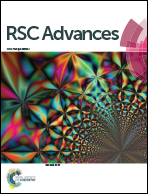Visible light assisted photocatalytic hydrogen generation by Ta2O5/Bi2O3, TaON/Bi2O3, and Ta3N5/Bi2O3 composites†
Abstract
Composites comprised of two semiconducting materials with suitable band gaps and band positions have been reported to be effective at enhancing photocatalytic activity in the visible light region of the electromagnetic spectrum. Here, we report the synthesis, complete structural and physical characterizations, and photocatalytic performance of a series of semiconducting oxide composites. UV light active tantalum oxide (Ta2O5) and visible light active tantalum oxynitride (TaON) and tantalum nitride (Ta3N5) were synthesized, and their composites with Bi2O3 were prepared in situ using benzyl alcohol as solvent. The composite prepared using equimolar amounts of Bi2O3 and Ta2O5 leads to the formation of the ternary oxide, bismuth tantalate (BiTaO4) upon calcination at 1000 °C. The composites and single phase bismuth tantalate formed were characterized by powder X-ray diffraction (PXRD), thermogravimetric analysis (TGA), Brunauer–Emmett–Teller (BET) surface area measurement, scanning electron microscopy (SEM), transmission electron microscopy (TEM), UV–Vis diffuse reflectance spectroscopy, and photoluminescence. The photocatalytic activities of the catalysts were evaluated for generation of hydrogen using aqueous methanol solution under visible light irradiation (λ ≥ 420 nm). The results show that as-prepared composite photocatalysts extend the light absorption range and restrict photogenerated charge-carrier recombination, resulting in enhanced photocatalytic activity compared to individual phases. The mechanism for the enhanced photocatalytic activity for the heterostructured composites is elucidated based on observed activity, band positions calculations, and photoluminescence data.


 Please wait while we load your content...
Please wait while we load your content...